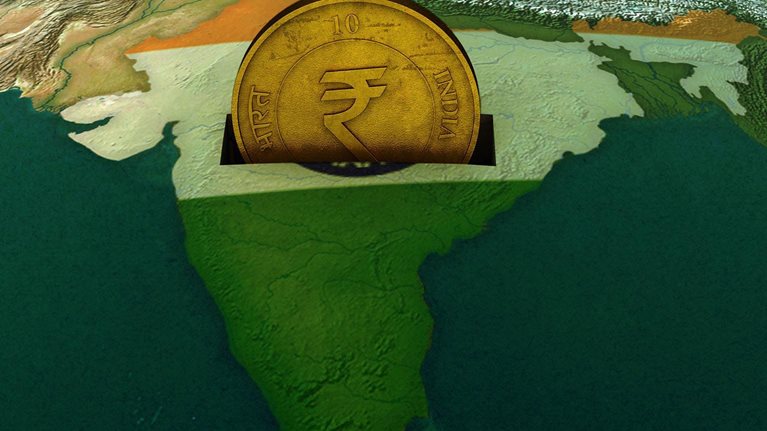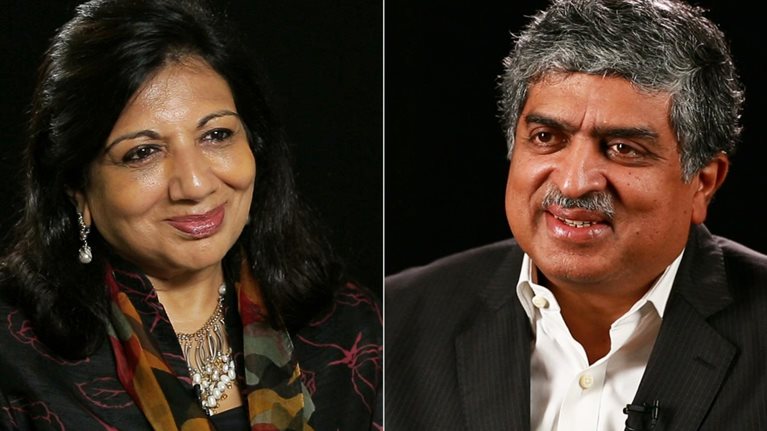India’s banking sector is a study in contrasts: it supports the world’s fastest-growing large economy but is grappling with challenges that test its strength and resilience.
Stay current on your favorite topics
Primary among them is the burden of distressed loans. According to Reserve Bank of India (RBI) data, the value of banks’ gross nonperforming assets (GNPA) and restructured assets reached $150 billion in April 2016 and has been growing by almost 25 percent year on year since 2013. State-owned banks account for more than three-fourths of the stressed-asset load, which is now far higher than their net worth. Provision levels are inadequate because these banks hold only 28 percent of GNPAs and restructured assets as provisions. There is a gap of close to $110 billion between the system’s stressed assets and the provisions made. These problems are considerably less severe for private banks.
Yet headline numbers do not tell the entire story, and there are many layers to the changing face of banking and finance in the world’s second most populous country. Even as legacy banks continue to be under pressure from stressed assets and stagnant loan growth, the sector as a whole represents one of the world’s biggest opportunities to create value in banking. Macroeconomic fundamentals continue to be strong, the country is in the midst of a digital revolution, and the ongoing disruptive changes (including momentum on the regulatory front) point to possibilities for both new entrants and incumbent banks.
The Indian government’s twin thrusts—to encourage digital identification and cashless transactions—are driving change throughout the economy. These measures picked up steam after the Unique Identification Authority of India (UIDAI), a statutory body responsible for providing the country’s residents with a biometric identity and a digital platform to authenticate it, was set up in 2016. The UIDAI has issued more than a billion unique identity (Aadhaar) cards, covering most of the country’s adult population. The government is pushing the whole financial system to use this unified identification system, and that has major implications for the sector. The system, which can be used not only for verifying customers but also for loans, direct transfers of subsidies, and a host of other financial transactions, could change the contours of formal and informal business in India.
In addition to the push for digitization, new policies favor financial inclusion and promote competition by allowing new domestic players to set up payments banks (which can only accept deposits and cannot issue loans or credit cards) and small-finance banks (which provide basic banking services to underserved sections of the economy). The further easing of norms, such as permission to set up wholly owned subsidiaries, makes it easier for foreign banks to enter India’s banking sector. Although processes are evolving, regulatory interventions point to the emergence of a digital, inclusive, and interoperable financial-services market in India.
A difficult legacy for Indian banking
Public-sector banks are more exposed to industry sectors with a higher share of nonperforming loans than their private-sector counterparts are. These state-owned institutions have deep networks and control 70 percent of banking’s asset base. From 2009 to 2016, the government made capital infusions of $15 billion into them. But over the years, value has steadily shifted toward private-sector institutions, whose share of the sector’s assets has grown to 25 percent, from 21 percent, in the past decade.1 (Foreign banks account for the remaining 5 percent.) The division is more apparent in the value banks created from 2006 to 2016: private banks have grown faster and generated far more value for their shareholders, with their share of market cap increasing from about 40 percent to nearly 70 percent in the same period.
Loan growth in fiscal year 2017 has remained anemic—the banks’ credit books shrank by 4 percent in the past quarter (Exhibit 1). With the balance sheets of major Indian companies continuing to be under stress, the volume of corporate loans fell by 3 percent from April to December 2016. Roughly 40 percent of the outstanding debt is to companies whose interest-coverage ratio is less than one,2 making debt repayment difficult. Overall, the recovery of wholesale-banking loans seems difficult in the medium term.

The Indian government’s decision to demonetize the currency—about 85 percent of it ceased to be legal tender on November 8, 2016—led to a surge in the current and savings-account (CASA) deposits of the country’s banks. Slow loan growth, combined with the higher CASA, has pushed down the banks’ credit-deposit ratios, a standard measure of loans to deposits. If credit offtake fails to pick up, these factors could affect the banks’ net interest income.
Promising developments in India
Notwithstanding the sectoral doom and gloom, India’s macroeconomic fundamentals continue to be strong. GDP has increased at 6.6 to 7.0 percent over the past four years, and International Monetary Fund projections show an upward trend—growth could reach 7.7 percent by 2020. Wholesale and retail inflation have been trending downward over the past three years.
Would you like to learn more about our Financial Services Practice?
The expansion and upward mobility of the middle class have transformed retail banking in India over the past decade. We expect these changes to continue as about 89 million households join this social segment by 2025.3 Upwardly mobile customers are more discerning, which is reflected in loyalty levels. Compared with their predecessors a decade ago, such consumers are half as likely to recommend a financial institution to an acquaintance and 15 percent more likely to shop around. They also have nearly 20 percent more banking relationships, on average.
These new customers, who represent the opening up of the banking marketplace, are more likely than yesterday’s to be attracted by one or another emerging value proposition. Most of them are rapid technology adopters, whose use of the Internet and mobile phones is growing (Exhibit 2). The falling cost of Internet access has facilitated the adoption of digital technologies. By December 2016, mobile data rates in India had fallen to almost 50 percent of their 2013 levels.4 Digital demand has shot up in consequence—exponential growth in the number of users and Internet use. More consumers rely on the Internet and mobile phones to meet their banking needs. The Indian Banks’ Association’s 2016 survey shows that almost 80 percent of transactions in the newer banks are made through digital channels.

At the same time, a regulatory push by the government and the RBI over the past few years is encouraging more competition and the emergence of digital business models. New categories of banking licenses have been launched—such as payments banks and small-finance banks. It’s also become easier for foreign players to enter the market, since they can now set up wholly owned subsidiaries in the country. This means that they can operate much as Indian-owned banks do, without restrictions on their branch footprints or their efforts to raise domestic capital.
Meanwhile, the government has launched what it calls the Jan Dhan (People’s Money) program, opening bank accounts for millions of previously unbanked customers to promote financial inclusion. About 280 million such accounts have been set up as of March 2017,5 allowing users to receive government subsidies and to access remittances, credit, insurance, and so on. Low-cost Indian platforms have been launched to promote digital payments—for example, RuPay, a cheaper, domestic alternative to international credit- or debit-card gateways such as MasterCard and Visa; the Unified Payment Interface (UPI), a system to facilitate the transfer of funds between bank accounts on the mobile platform; and the Bharat Interface for Money (BHIM), a mobile app based on UPI.
The availability of data in India has become more democratic, and with IndiaStack and open application programming interfaces (APIs) banks can now access customer information from a single source. Many of these digital-finance initiatives use the national unique identification number (Aadhaar) to authenticate customers. The recently launched DigiLocker, for example, is a cloud-based document-repository system that enables the sharing of digitized identity documents and certificates.
These developments give financial players opportunities to build innovative business models serving millions of new consumers. Both new entrants, free of legacy issues and with much lower infrastructure costs, and innovative incumbents have an advantage in reaching and serving customers. Since many existing banks have balance-sheet limitations, relatively unconstrained ones also have an opportunity to take over some wholesale loans on their own terms. In addition, disruptions, both in technology and policy, could help new banks create value and increase their efficiency.
Moving the banking sector forward
Despite the tremendous potential and opportunity, incumbents and new entrants alike could use a few boosts to overcome traditional roadblocks.
Leverage the ‘data tsunami’ for customer insights
Reliable, diverse data sources are emerging in India, and these could be used to make smarter and faster decisions in financial services (Exhibit 3). In addition to the traditional sources, such as financial-transaction records and credit bureaus, banks can now tap into information from e-commerce purchases, utility payments, and social media.

With Aadhaar identifying individual customers, financial-services players can also serve them more intelligently, with faster approvals, more customized products, and better underwriting decisions. Combining traditional and nontraditional sources of data on customers allows players to get a more comprehensive picture of them. Many fintechs are already encroaching on the traditional banking space by using the “data tsunami” to come up with disruptive business models that address unmet financing needs.
Cultivate partnership-driven digital ecosystems
Some of the most significant opportunities in Indian banking over the next three to five years will accrue to partnerships, a strategy that will require banks to embed themselves in the daily lives of customers to meet their financing needs. A payments bank, for example, can allow customers to cash in or cash out through local retailer outlets, bypassing the need for traditional (and more expensive) branches and ATMs.
This approach will require banks to build close relationships with partners, creating integrated digital infrastructures that span their individual platforms. This mechanism of being able to embed into another ecosystem and build an entirely digital model, relies on the physical networks of the partners to access customers. It has the potential to change the economics and the ability to serve underserved segments.

India’s ascent: Five opportunities for growth and transformation
Tap growing credit demand from small and midsize enterprises
With corporate loan books continuing to shrink, the next growth opportunity will be serving India’s vast number of small and medium enterprises (SMEs). Currently, most of them look to the informal sector and nonbanking financial companies for their financing needs. With the push from the informal to the formal economy, an estimated 50 million SMEs could enter the formal banking space by 2020.6
Traditional banks will face challenges to serve these customers in the face of stiff competition from nonbanking financial companies and fintechs. Small businesses that turn to informal financing channels do so because they cannot raise the collateral banks require. High interest rates, indebtedness, and processing demands are frequently cited reasons for bypassing formal lenders. To address these issues, banks will need to review their traditional lending mechanisms, which are not suitable for SMEs or micro, small, and medium enterprises. To assess the creditworthiness of SMEs, price risk, and set appropriate loan limits, banks will need to use unstructured data—such as prior transaction details and data from the Goods and Services Tax (GST) platform and even from social media.
As we said at the outset, India’s banking sector is at a crossroads. Traditional players face huge disruptions, while digital growth is propelling changes in technology and customer mind-sets. This period of disruption presents tremendous growth opportunities. Old banks will need to make bold moves and initiate major transformations to take advantage of them. The path for new players, which are not saddled with the problems of the past, and for existing but relatively unconstrained banks is considerably easier. Those that master these new realities could build truly world-class banking businesses at scale.
To request a copy of the full report, see “Mastering new realities: A blueprint to transform Indian banking.”


